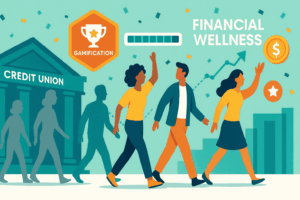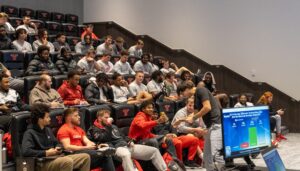When designing a college personal finance program, it’s crucial to strike a balance between comprehensive coverage and practicality. The content you choose should equip students with essential skills and knowledge while ensuring they can immediately apply what they learn to their financial lives. Here, Ostrich expands on the key content topics mentioned in the previous blog post “Comprehensive Personal Finance Program For Universities” and provide insights into enhancing the effectiveness of your program.
What Content to Cover in Your College Personal Finance Program
The content you cover should be tailored to your audience as best as possible. If you are speaking with all freshman the topics and framing of the information is more about maximizing your time in school. Where as if you are speaking with all seniors the focus of the content in your personal finance program should focus more on life after college.
Additionally, you can utilize Ostrich’s free financial health score as a way to understand where your college students are today and what topics to focus based on their needs. Ostrich’s financial health score can then be used to measure the impact the content covered in your college personal finance program has on students behaviors.
Building Credit Safely
Building a strong credit history is an essential step towards financial independence. To delve deeper, consider discussing:
- Credit Reports and Scores: Teach students how credit scores are calculated, what factors affect them, and how to obtain their credit reports for free.
- Credit Building Strategies: Explore various methods for building credit, such as becoming an authorized user, secured credit cards, and responsible credit card usage.
- Credit Mistakes to Avoid: Highlight common credit pitfalls, like carrying high balances, missing payments, and opening too many accounts.
- Credit Monitoring: Introduce students to tools for monitoring their credit scores and protecting against identity theft.
Saving
While the concept of saving is familiar, students can benefit from a deeper understanding of:
- Emergency Funds: Explain the importance of having an emergency fund and how to set aside funds for unexpected expenses.
- High-Yield Savings Accounts: Compare different types of savings accounts, their interest rates, and how to avoid fees.
- Compound Interest: Elaborate on how compound interest works, its role in growing savings, and the benefits of starting to save early.
- Budgeting for Savings: Help students create a budget that allocates a portion of their income to savings goals, reinforcing the habit of saving consistently.
Investing for the Long-Term
To demystify investing, consider expanding on the following topics:
- Diversification: Teach the importance of diversifying investments to manage risk and achieve long-term growth.
- Types of Investments: Introduce stocks, bonds, mutual funds, and exchange-traded funds (ETFs), along with their potential risks and rewards.
- Retirement Accounts: Discuss the advantages of retirement accounts like 401(k)s and IRAs, and explain how contributions and investments within these accounts work.
- Tax-Efficient Investing: Cover strategies for minimizing taxes on investment gains, such as holding investments in tax-advantaged accounts like IRAs.
Student Loans and Debt
Help students navigate the complexities of student loans and debt management:
- Loan Repayment Options: Detail various repayment plans, including income-driven repayment, deferment, and forgiveness programs.
- Loan Consolidation and Refinancing: Explain the pros and cons of consolidating or refinancing loans and how they can impact interest rates and terms.
- Managing Debt: Provide guidance on distinguishing between “good” and “bad” debt, and offer strategies for managing and reducing high-interest debt.
- Budgeting for Loan Payments: Help students incorporate loan payments into their budgets and explore tools for staying organized.
Spending and Budgeting
Emphasize the importance of mindful spending and budgeting within the context of students’ daily lives:
- Tracking Expenses: Teach students how to track and categorize their expenses using apps, spreadsheets, or budgeting tools.
- Creating a Budget: Walk students through the process of creating a budget that aligns with their financial goals and priorities.
- Needs vs. Wants: Encourage students to differentiate between essential expenses and discretionary spending, fostering better spending habits.
- Behavioral Economics: Introduce behavioral economics concepts to help students understand and overcome impulsive spending tendencies.
Advanced Topics
As students become more confident in their financial knowledge, gradually introduce more advanced concepts, such as:
- Taxes: Provide an overview of income taxes, deductions, and tax-favored accounts, preparing students for tax season.
- Investment Strategies: Explore advanced investment strategies like asset allocation, rebalancing, and investing in individual stocks.
- Homeownership: Discuss the process of buying a home, including mortgages, down payments, closing costs, and ongoing homeownership expenses.
Interactive Learning
To enhance engagement and understanding, consider incorporating interactive elements into your program:
- Case Studies: Present real-life scenarios that challenge students to apply their knowledge to practical situations.
- Group Activities: Organize group discussions, role-playing exercises, or financial simulations to encourage collaboration and critical thinking.
- Guest Speakers: Invite financial professionals, alumni, or community members to share their experiences and insights.
Measuring Success of the Content in Your College Personal Finance Program
Establish clear metrics for success and progress throughout the program:
- Assess Knowledge Gained: Use quizzes, assessments, or assignments to gauge students’ comprehension of key concepts.
- Behavioral Changes: Monitor changes in students’ financial behaviors, such as increased savings, improved credit management, and reduced unnecessary spending.
Wrapping Up
By thoughtfully expanding the content of your college personal finance program and incorporating interactive elements, you can empower students to make informed financial decisions, cultivate responsible habits, and achieve long-term financial success. Remember that the ultimate goal is to equip students with the tools they need to navigate their financial journey with confidence and competence.














